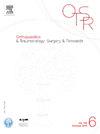关节镜 Trillat 术后肩胛下肌萎缩和功能。
IF 2.3
3区 医学
Q2 ORTHOPEDICS
引用次数: 0
摘要
导言:一些研究报告称,Latarjet 手术后会出现内旋(IR)力量不足,这种情况可能会持续数月甚至数年。关节镜下的 Trillat 手术不需要分割肩胛下肌,因此对肩胛下肌的损伤可能较小:假设:关节镜 Trillat 手术不会导致肩胛下肌萎缩或力量不足:这是对2013年至2021年间接受治疗的患者进行的一项单中心回顾性研究。纳入的患者均患有慢性肩关节前方不稳,有使用关节镜Trillat手术稳定的指征,术前接受了CT扫描,术后6个月接受了第二次CT扫描。对所有肩袖肌肉进行了以下形态学参数测量:横截面积(CSA)、厚度和脂肪浸润(使用平均肌肉衰减(MMA)测量法)。术后一年进行等速运动测试:2013年至2021年期间,177名患者接受了关节镜下Trillat手术,其中58名患者接受了手术,30名患者接受了分析,17名患者接受了等动能测试。肩胛下肌的CSA明显小了5.3%(17.0 vs 16.1;P = 0.03)。其他肩袖肌肉的 CSA 都没有变小。术后肩胛下肌的MMA明显增加,而外旋肌的MMA则有所减少。术后一年,肩内肌和外转子肌均未发现力量不足:讨论:关节镜下的 Trillat 手术在 6 个月时会导致肩胛下肌轻微萎缩,术后 1 年时没有力量缺失。有几项研究报告称,Latarjet术后会出现内旋肌力不足,根据研究的不同从6%到19%不等:证据等级:IV。本文章由计算机程序翻译,如有差异,请以英文原文为准。
Subscapularis atrophy and function after arthroscopic Trillat procedure
Introduction
Several studies have reported a strength deficit in internal rotation (IR) following a Latarjet procedure, which can persist for months or even years. The arthroscopic Trillat procedure does not require splitting the subscapularis muscle, potentially making it less damaging.
Hypothesis
The arthroscopic Trillat procedure does not cause any atrophy or strength deficit in the subscapularis muscle.
Methods
This was a single center, retrospective study of patients treated between 2013 and 2021. Included were patients who had chronic anterior shoulder instability with an indication for surgical stabilization using an arthroscopic Trillat procedure and who underwent a CT scan before surgery and a second one at 6 months postoperative. The following morphological parameters were measured on all the rotator cuff muscles: cross-sectional area (CSA), thickness and fatty infiltration using the mean muscle attenuation (MMA) measurement. Isokinetic tests were done 1 year post-surgery.
Results
One hundred seventeen patients underwent arthroscopic Trillat surgery between 2013 and 2021; 58 were included, 30 were analyzed and 17 patients underwent isokinetic testing. The CSA of the subscapularis was significantly smaller by 5.3% (17.0 vs. 16.1; p = 0.03). None of the other rotator cuff muscles had a smaller CSA. The MMA of the subscapularis increased significantly while the MMA of the external rotators decreased postoperatively. No strength deficit was found at 1 year postoperative in the internal and external rotators.
Discussion
The arthroscopic Trillat procedure produces minor atrophy of the subscapularis muscle at 6 months, with no strength deficit at 1 year postoperative. Several studies have reported a deficit in internal rotation strength after a Latarjet procedure, ranging from 6% to 19% depending on the study.
Level of evidence
IV.
求助全文
通过发布文献求助,成功后即可免费获取论文全文。
去求助
来源期刊
CiteScore
5.10
自引率
26.10%
发文量
329
审稿时长
12.5 weeks
期刊介绍:
Orthopaedics & Traumatology: Surgery & Research (OTSR) publishes original scientific work in English related to all domains of orthopaedics. Original articles, Reviews, Technical notes and Concise follow-up of a former OTSR study are published in English in electronic form only and indexed in the main international databases.

 求助内容:
求助内容: 应助结果提醒方式:
应助结果提醒方式:


